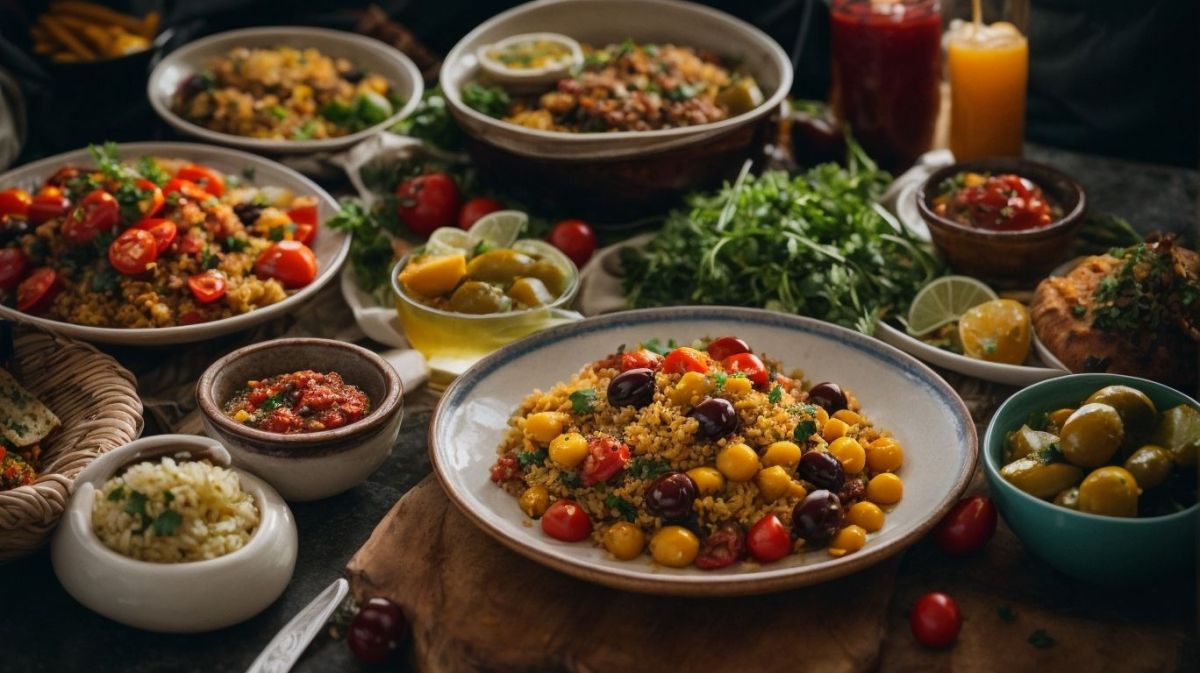Imagine sun-drenched islands, the scent of oregano and thyme mingling with the salty sea air. Picture vibrant plates overflowing with fresh vegetables, bursting with the flavors of Greece. This journey explores the captivating world of Greek vegetarian island cuisine, revealing iconic dishes, regional variations, and the secrets to recreating these culinary masterpieces in your own kitchen. We’ll delve into the history, the techniques, and the very essence of a Greek island meal, transporting you to sun-kissed shores with every bite.
From the hearty giant beans simmered with sun-ripened tomatoes and fragrant herbs to the delicate artistry of stuffed vegetables bursting with fresh flavors, we uncover the unique culinary heritage of each island. We’ll explore how local ingredients and traditional cooking methods shape the distinctive character of each dish, painting a vivid picture of Greek island life through its vibrant food culture. Prepare to be inspired by the simplicity, the freshness, and the undeniable deliciousness of Greek vegetarian cooking.
Exploring Regional Variations
The diverse geography of the Greek islands profoundly impacts their culinary traditions, leading to fascinating variations in vegetarian dishes. Each island, with its unique microclimate and available ingredients, boasts a distinct culinary identity, showcasing the ingenuity of Greek cuisine in adapting to its environment. We will explore three distinct islands to highlight these regional differences.
Regional Vegetarian Cuisine: Crete, Naxos, and Santorini
The sun-drenched landscapes and fertile soils of these islands contribute to the abundance of fresh produce that forms the heart of their vegetarian cooking. The differences, however, are striking, reflecting not only the varied terrains but also the historical influences and culinary evolution of each location.
Cretan Vegetarian Dishes
Crete, the largest of the Greek islands, is known for its robust, earthy flavors. Its mountainous interior and coastal plains yield a bounty of vegetables, herbs, and wild greens. The Cretan diet, renowned for its health benefits, emphasizes simplicity and the use of fresh, seasonal ingredients. A quintessential example is dakos, a hearty barley rusk topped with ripe tomatoes, crumbled feta cheese (often omitted for a strictly vegetarian version), olive oil, and oregano, representing the island’s sun-drenched produce and simple pleasures. Another example is horta, a vibrant mix of wild greens, often including dandelion, chickweed, and mustard greens, boiled and dressed with olive oil and lemon juice, showcasing the island’s connection to the land and its wild bounty. The emphasis is on the natural flavors of the ingredients, minimally processed and celebrated for their inherent qualities.
Naxian Vegetarian Dishes
Naxos, with its rich volcanic soil and abundant water sources, produces a wealth of vegetables and fruits, including plump tomatoes, vibrant peppers, and fragrant herbs. Naxian cuisine features dishes that reflect this abundance, often incorporating local cheeses (which can be omitted for vegetarian versions) and incorporating a broader range of herbs than found in some other regions. A representative dish is patates fournou, baked potatoes seasoned with herbs like rosemary and thyme, and sometimes accompanied by local cheeses (again, easily omitted for a vegetarian version). The potatoes, baked to perfection, absorb the fragrant herbs, creating a simple yet satisfying dish. The use of fresh herbs is central to Naxian cooking, adding depth and complexity to otherwise straightforward preparations.
Santorini Vegetarian Dishes
Santorini, with its dramatic volcanic landscape and arid climate, offers a unique culinary perspective. The island’s limited arable land necessitates a focus on resourceful cooking, maximizing the use of every available ingredient. Tomatoes, fava beans (a staple), and eggplant are key ingredients, often featured in simple yet flavorful preparations. Fava Santorinis, a creamy yellow split pea puree, is a classic example. Served with capers, caramelized onions, and olive oil, it showcases the island’s resourcefulness and the ability to transform humble ingredients into a culinary masterpiece. The use of herbs is more restrained in Santorini, allowing the inherent flavors of the main ingredients to shine through.
Comparative Analysis of Herbs and Spices
The use of herbs and spices varies significantly across these three islands. Cretan cuisine relies heavily on oregano, rosemary, and thyme, reflecting the island’s abundance of these herbs. Naxos incorporates a wider variety, including marjoram and mint, adding a complexity to its dishes. Santorini, due to its arid climate, employs herbs more sparingly, letting the inherent flavors of the vegetables take center stage. While all three islands utilize olive oil extensively, its role differs subtly: in Crete, it is often the primary flavor enhancer, while in Naxos and Santorini, it complements the other ingredients without dominating the palate.
Signature Vegetarian Dish Ingredients
The following bullet points detail the specific ingredients used in a signature vegetarian dish from each island. Note that variations exist, and these are representative examples.
- Cretan Dakos: Barley rusk, ripe tomatoes, olive oil, oregano, crumbled feta cheese (optional for vegetarian version).
- Naxian Patates Fournou: Potatoes, rosemary, thyme, olive oil, garlic (optional), local cheese (optional for vegetarian version).
- Santorini Fava Santorinis: Fava beans, capers, caramelized onions, olive oil, lemon juice.
Step-by-Step Recipes
A journey through Greek vegetarian cuisine wouldn’t be complete without experiencing the vibrant flavors of a classic island dish. Giant beans with tomatoes and herbs, or Gigantes plaki, is a testament to the simplicity and deliciousness of Greek cooking, showcasing the bounty of the Mediterranean. This recipe provides a detailed guide to creating this iconic dish, along with tips for visual presentation and dietary adaptations.
Giant Beans with Tomatoes and Herbs (Gigantes Plaki)
This recipe serves 4-6 people and requires approximately 1 hour of cooking time.
Ingredients:
- 1 cup dried giant beans (Gigantes), soaked overnight
- 1 large onion, finely chopped
- 2 cloves garlic, minced
- 1 (28 ounce) can crushed tomatoes
- 1 cup vegetable broth
- 1/2 cup extra virgin olive oil
- 1/4 cup chopped fresh parsley
- 1/4 cup chopped fresh dill
- 2 tablespoons dried oregano
- 1 teaspoon sugar
- Salt and freshly ground black pepper to taste
- Optional: 1/2 cup chopped fresh mint
- Optional: 1/4 cup Kalamata olives, pitted and halved
Instructions:
- Drain and rinse the soaked giant beans. In a large pot, combine the beans, vegetable broth, and a generous pinch of salt. Bring to a boil, then reduce heat to low, cover, and simmer for about 45-60 minutes, or until the beans are tender but not mushy.
- While the beans are simmering, heat the olive oil in a large skillet over medium heat. Add the chopped onion and cook until softened, about 5 minutes. Stir in the minced garlic and cook for another minute until fragrant, being careful not to burn the garlic.
- Add the crushed tomatoes, oregano, sugar, salt, and pepper to the skillet. Bring to a simmer and cook for 15-20 minutes, stirring occasionally, until the sauce has thickened slightly. The sauce should develop a rich, deep red color.
- Stir the cooked giant beans into the tomato sauce. Add the fresh parsley and dill. If using, add the mint and Kalamata olives at this stage. Simmer for another 5 minutes to allow the flavors to meld.
- Taste and adjust seasoning as needed. You may want to add more salt, pepper, or a squeeze of lemon juice for brightness.
Plating and Garnishing
The visual appeal of Gigantes plaki is as important as its taste. Serve the stew in a shallow, wide bowl to showcase the vibrant colors of the beans and the rich tomato sauce. A rustic, earthenware bowl enhances the traditional feel. Garnish generously with fresh herbs – a scattering of parsley, dill, and a sprig of fresh oregano add a pop of green and enhance the aroma. A drizzle of extra virgin olive oil adds shine and richness. A sprinkle of crumbled feta cheese (omit for vegan) adds a salty, tangy contrast. Consider placing a few Kalamata olives on top for an extra touch of color and flavor. Imagine the deep red of the sauce contrasting beautifully with the plump, glistening beans and the vibrant green of the herbs.
Dietary Adaptations
Vegan Adaptation: Simply omit the feta cheese. Ensure your vegetable broth is vegan-friendly. The recipe is naturally gluten-free.
Gluten-Free Adaptation: This recipe is naturally gluten-free, as long as you ensure that your vegetable broth does not contain any gluten-containing additives.
Beyond the Recipe

Stepping beyond the detailed instructions and tantalizing aromas of Greek vegetarian cuisine, we delve into the heart of the island experience itself. The true magic lies not just in the dishes themselves, but in the vibrant atmosphere and rich culture that surrounds their creation and consumption. These recipes are more than just ingredients and steps; they are portals to a way of life.
The ambiance of a typical Greek island taverna is a symphony of sights, sounds, and scents. Imagine sun-drenched whitewashed walls, adorned with bougainvillea spilling over terracotta pots. Rustic wooden tables, often adorned with simple checkered cloths, are scattered under the shade of olive trees or a sprawling pergola, their surfaces worn smooth by years of laughter and conversation. The air hums with the gentle buzz of cicadas, a soundtrack to the rhythmic clatter of cutlery and the murmur of voices. The aroma of oregano, thyme, and lemon fills the air, mingling with the salty tang of the nearby sea. A gentle breeze carries the scent of grilling vegetables, their sweetness mingling with the smoky notes of charcoal.
The Social and Cultural Context of Sharing Meals
Sharing food in Greece is an integral part of the social fabric, a ritual that transcends mere sustenance. Meals are communal affairs, a celebration of togetherness and a testament to the importance of family and friendship. The emphasis is not on individual portions, but on the abundance of shared dishes placed at the center of the table, encouraging conversation and connection. Traditional customs often involve the offering of “mezedes,” small plates of appetizers, fostering a relaxed and convivial atmosphere before the main course. Dining etiquette is generally informal and relaxed; the focus is on enjoyment and sharing, not rigid formality. The breaking of bread together is a symbolic act of unity and hospitality. It’s not uncommon for strangers to find themselves sharing a table and stories with locals, forging bonds over a plate of delicious food.
A Memorable Greek Vegetarian Meal
The sun dipped below the horizon, painting the Aegean Sea in fiery hues of orange and purple. We sat at a weathered table overlooking the shimmering water, the gentle lapping of waves providing a soothing counterpoint to the lively chatter around us. The taverna, nestled in a secluded cove on Naxos, was a haven of rustic charm. Our meal began with a vibrant array of mezedes: creamy hummus, glistening olives, sun-dried tomatoes bursting with flavour, and a medley of grilled vegetables marinated in fragrant herbs. The main course was a feast of its own – a hearty spanakopita, its flaky pastry encasing a rich spinach and feta filling, accompanied by a fragrant lemon-herb roasted artichoke and a simple yet satisfying giant bean salad. The food was exceptional, but it was the shared laughter, the easy conversation with our newfound friends, and the breathtaking view that truly etched this meal into memory. The warm glow of the setting sun, the taste of the perfectly ripe tomatoes, the sound of the sea – these were the elements that transcended the simple act of eating, creating an experience far richer and more profound than any recipe could ever capture.
This exploration of Greek vegetarian island dishes has unveiled a culinary tapestry rich in history, tradition, and unforgettable flavors. More than just recipes, these dishes are windows into the heart of Greek island culture, offering a taste of the warmth, the simplicity, and the vibrant spirit of the islands themselves. Whether you’re recreating a classic recipe in your kitchen or savoring these dishes in a sun-drenched taverna, the experience is a journey for the senses, a vibrant celebration of fresh ingredients, and a testament to the enduring power of culinary tradition.
Questions Often Asked
What are some common vegetarian staples found in Greek island cooking besides olives and tomatoes?
Eggplant, zucchini, peppers, artichoke hearts, fava beans, and various greens like spinach and chard are frequently used.
Are there any specific dietary considerations I should be aware of when ordering vegetarian food in Greece?
While many Greek dishes are naturally vegetarian, some may contain hidden animal products like butter or cheese. It’s always best to double-check with your server about ingredients, especially if you have strict dietary requirements (vegan, etc.).
Where can I find authentic Greek ingredients outside of Greece?
Specialty food stores, international markets, and online retailers often carry authentic Greek herbs, spices, and olive oils. Look for brands that specifically source their ingredients from Greece.
What’s the best way to store leftover Greek vegetarian dishes?
Store leftovers in airtight containers in the refrigerator for up to 3-4 days. Many dishes, particularly those with fresh herbs, are best enjoyed fresh, but proper storage will maintain their quality.


